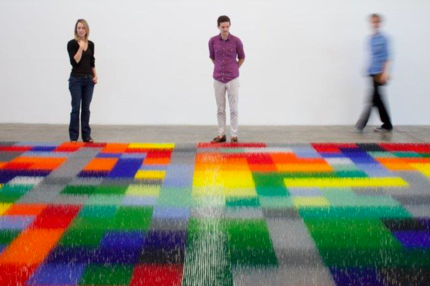
Anything can happen when the artist Liza Lou, who frequently seeks out community participation, gathers a group to help her assemble artworks for her exhibitions. “I’ve had situations where people meet each other and end up getting married,” she says — an observation she’s quick to qualify. “I don’t want to publicly promise that if you work on my project, you’ll end up married. But it’s self-selecting. The people who come tend to be interested in art. It can bring out some quirkiness.”
Most recently, Lou gathered a group from Westchester County to help her piece together a grid comprised of blocks of upright stainless-steel wires covered in beads. The resulting form evokes a colorful patchwork field of multicolored blades of grass. “Color Field,” Lou’s largest sculpture to date, is on view starting this weekend at the Neuberger Museum of Art along with the artist’s “Solid Grey” and “Color/White” canvases, two series of woven beaded works. Lou’s beads, too, are the results of collaborative work: She employs local female artisans at her studio in Durban, South Africa, to help her create them.
Lou emphasizes that while her own creative process is crucial to her work, she wants viewers to experience her pieces with fresh, unbiased eyes — she hopes that explanations aren’t necessary, that people will enjoy the pieces for their visual merit before seeking out information about their backstories. You’d be missing out, though, if you never learned what goes into Lou’s creations. She speaks thoughtfully, if tentatively, about her unique process of art-making, and what it can and can’t do. “There aren’t that many activities we have where people can gather as a culture in a non-commercial setting where nothing’s for sale and where you’re not being proselytized in a kind of religious experience,” she says. “It’s an opportunity to get together and make something. I don’t know if it makes us better. I don’t know if art makes us better. All I try to do is put people in these situations where something might happen.”
Photo by Pablo Mason, courtesy of the Museum of Contemporary Art San Diego
